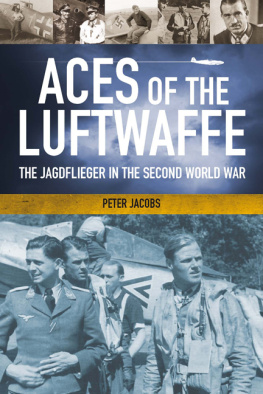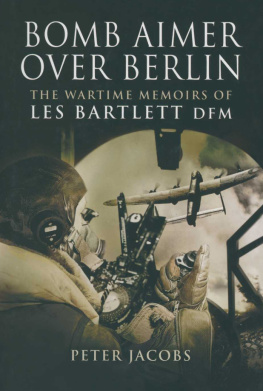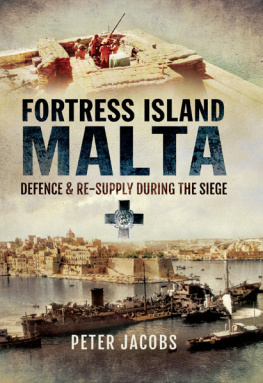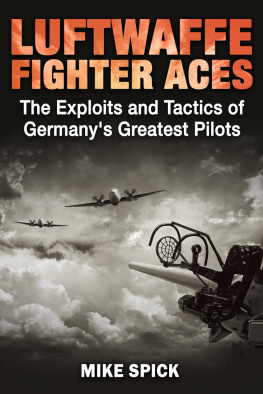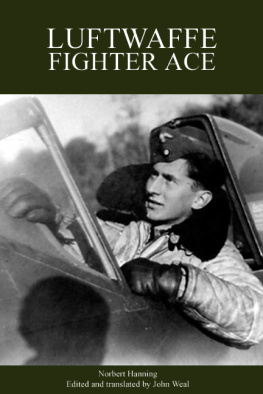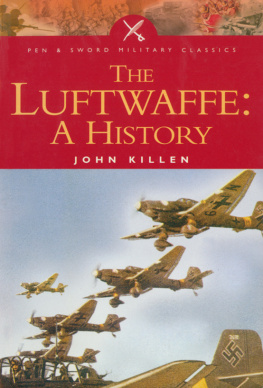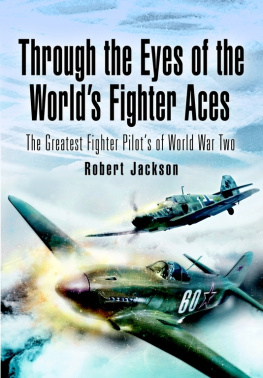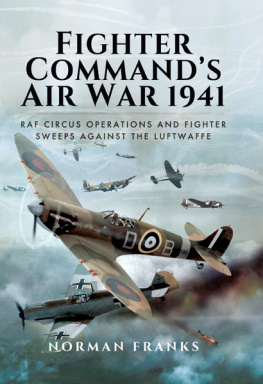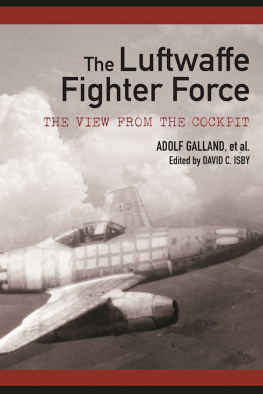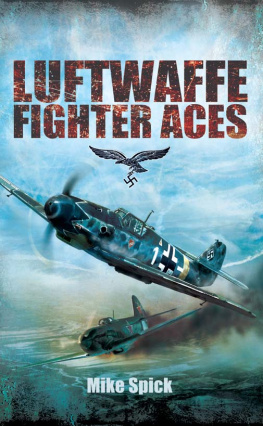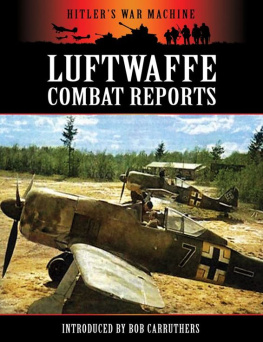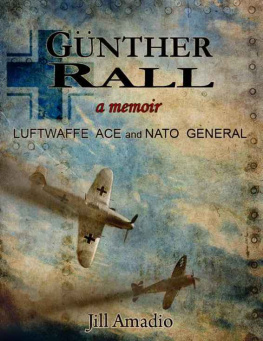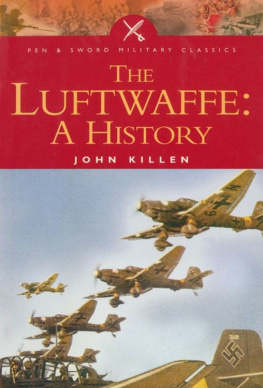

Aces of the Luftwaffe
This edition published in 2014 by Frontline Books,
an imprint of Pen & Sword Books Ltd,
47 Church Street, Barnsley, S. Yorkshire, S70 2AS
www.pen-and-sword.co.uk
Copyright Peter Jacobs, 2014
The right of Peter Jacobs to be identified as the author of this work
has been asserted by him in accordance with the
Copyright, Designs and Patents Act 1988.
ISBN: 978-1-84832-689-7
eISBN: 9781473840874
All rights reserved. No part of this publication may be reproduced, stored in or introduced into a retrieval system, or transmitted, in any form, or by any means (electronic, mechanical, photocopying, recording or otherwise) without the prior written permission of the publisher. Any person who does any unauthorized act in relation to this publication may be liable to criminal prosecution and civil claims for damages.
CIP data records for this title are available from the British Library
For more information on our books, please visit
www.pen-and-sword.co.uk, email info@frontline-books.com
or write to us at the above address.
Printed and bound by CPI Group (UK) Ltd, Croydon CR0 4YY
Typeset in 10.5/15 pt ITC Slimbach
Contents
Plates
Plate 1: |
Plate 2: |
Plate 3: |
Plate 4: |
Plate 5: |
Plate 6: |
Plate 7: |
Plate 8: |
Plate 9: |
Plate 10: |
Plate 11: |
Plate 12: |
Plate 13: |
Plate 14: |
Plate 15: |
Plate 16: |
Plate 17: |
Plate 18: |
Plate 19: |
Plate 20: |
Plate 21: |
Plate 22: |
Plate 23: |
Plate 24: | . |
Acknowledgements
H aving spent a full career in the Royal Air Force, and having served on a number of the RAFs finest fighter squadrons, I was personally delighted when Michael Leventhal gave me the opportunity to write this book. While I have written many books and articles about the RAF during the Second World War, this gave me an exciting opportunity to take another look at many of those same air campaigns but this time from the opposite end of the telescope and to look at them from the Luftwaffes perspective. How fascinating it proved to be.
The subject is hardly new to military historians as it has been covered in various formats many times before but I was keen to set each air battle into context so that the reader understands why the Luftwaffe was involved in a specific campaign and why a particular individual was fighting in combat at that time.
Mike Spick covered the topic superbly well in his book Luftwaffe Fighter Aces , which he wrote for Greenhill Books nearly twenty years ago, and this proved to be an excellent place to start. I am particularly grateful to Mike for taking the time to go through my work and for providing me with extremely helpful advice on a subject that he has studied for many years.
As my research continued, I was keen to look deeper behind the scenes so that I could understand why the air battles were being fought and also to understand the views and beliefs of some of the Luftwaffes leaders that were shaping the air war over the many fronts that it fought.
While an increasing amount of information has come into the public domain through being made available online, institutions such as the Bundesarchiv-Militrarchiv at Freiburg and the National Archives at Kew will always remain the repositories of information and illustrations. As a military historian and author, I am so grateful to both organizations for the use of material and illustrations over the years. I am also extremely fortunate to have been allowed privileged access to the Air Historical Branch at RAF Northolt and have spent the last nine years of my service career at the RAF College Cranwell, which boasts one of the finest libraries in the country, and so I am always pleased to be able to offer my thanks to the staff of both the AHB and the RAF College in this way.
Away from the more formal institutions, there are no end of excellent books and publications on the Luftwaffe. Whether the reader is a novice or is someone who has studied the subject in great depth over many years, there are plenty of publications to choose from. Unsurprisingly, many have come from Germany, for example from the highly acclaimed author Jochen Prien, but there are also many others published outside of Germany that have been written by extremely knowledgeable authors who have been fortunate to have access to veterans and archives over many years. These include books written by Theo Boiten, Martin Bowman, Robert Forsyth, Tony Holmes, Eric Mombeek, Simon Parry and Dr Alfred Price to name just a few, but I would like to thank three authors, in particular, who took the time to help me. First of all I would like to thank my colleague Chris Goss, another former RAF officer, who somehow seems to have found the time to write numerous titles on the Luftwaffe over the years. My thanks also go to Donald Caldwell in the United States, another Frontline author who is specifically knowledgeable on JG 26, one of the finest fighter wings, and to John Weal who has written a number of superbly illustrated titles for Osprey Publishing. I consider all three to be experts in their fields and I am extremely grateful to them all for their time, their willingness to help and for providing me with the superb illustrations included in this book. I could not have managed without them. I would also like to thank the reviewers at Frontline for their advice and comments; I have learned so much from them as well.
Finally, I would like to thank Michael, once again, and his team at Frontline Books for the finished product you see today.
Introduction
C onflict has been around for thousands of years but war in the air is just a hundred years old. The Luftwaffe, at the forefront of Hitlers war machine during the Second World War, was in existence for just ten of those years yet it produced some of the greatest names in the history of air combat and produced the highest scoring fighter pilots of all time.
During the Second World War, an Allied fighter pilot was considered to be exceptional if he was credited with thirty or forty victories. Even the top scoring Allied fighter pilot, the Soviet ace Ivan Kozhedub, credited with sixty-two victories, was completely over-shadowed by well over a hundred Luftwaffe pilots, called Jagdflieger , who all exceeded his score. If using the generally accepted definition of an ace as being a pilot who achieved five aerial victories, then the Luftwaffe produced aces in the thousands but rather than use the term ace, the Luftwaffe used the term Experte as recognition of proficiency in the air as well as acknowledging the number of victories achieved.
How the Luftwaffe managed to produce so many high-scoring fighter pilots compared to the Allies is often the subject of great debate. Those sceptical about the figures will believe the claims to be highly exaggerated but a fighter pilot may genuinely have believed that he had achieved success, even though it may not have always been possible to confirm the success with evidence. For example, an enemy aircraft may have last been seen descending into cloud emitting smoke and flames or may have crashed into the sea but was unobserved by anyone else, and at night it would often prove impossible to observe the outcome of a quick aerial engagement when attacking large numbers of enemy bombers; the fighter pilot rarely had time to observe the result of his encounter.

